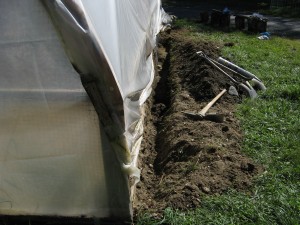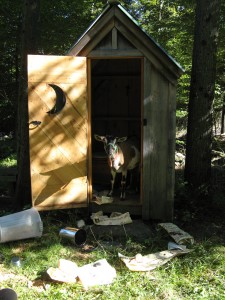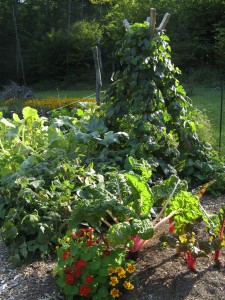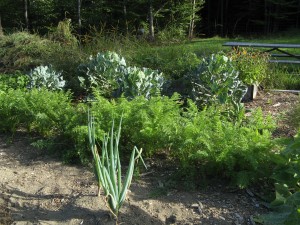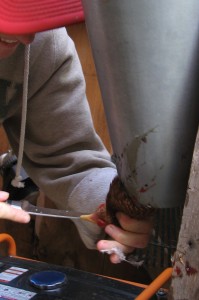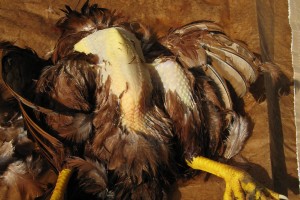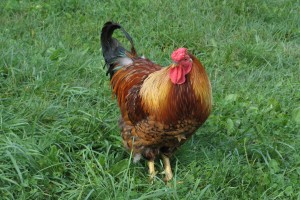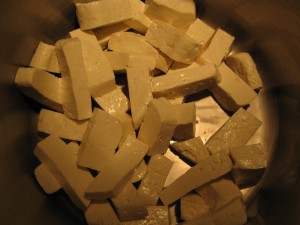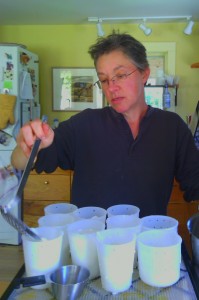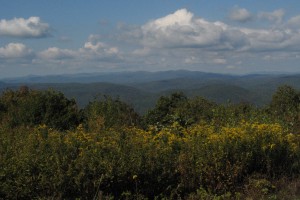My fourteenth farm was Panic Swamp Farm in Putney, Vermont.
The Farm
The farmers are Alison and Meg. Alison grew up on a farmette in Connecticut with cows, chickens and a large garden. Her mom was a do-it-yourself type which rubbed off on Alison. One day while Meg and Alison were living in Brattleboro, their daughter told them of a vision she had of buying land, raising goats and making cheese. Meg and Alison went with the idea and together with their daughter bought a piece of land to start the farm. Right after they signed the purchase agreement, a man told them they’d just bought a swamp. Their immediate reaction was panic, hence the name Panic Swamp. Instead of worrying about their new land, they decided to embrace the swamp.
My Farming Experience
Sometimes unexpected things happen on a farm that take time away from what you would prefer to be working on. Much of my time at Panic Swamp Farm was spent tending to the unexpected. Alison had recently discovered that a rat was burrowing into the greenhouse where the chickens lived. During my first days at the farm, Alison and I dug a one foot deep trench around the greenhouse and put in wire fencing below the sides of greenhouse that would hopefully keep the rat out. We only got half way around the green house before we got worn out from the digging. On my second morning on the farm, Alison went out to check on the vegetable garden and found blight had hit her tomatoes. Racing to get done before Zumba class, Alison, Meg and I pulled the tomatoes off the vines and piled up the infected vines to be taken away to the dump. The following morning I milked the two goats, Wreat and Rizzo on my own for the first time. Everything went smoothly. I left them in their stall in the barn to take the milk back to the house. A little later Alison went down to the barn to move the goats to the pasture. She found that the goats had opened the stall door and wreaked havoc in the milking parlor. They knocked over everything they could reach in the hopes of finding a treat to eat and messed up the electronics for the electric fences. Alison spent part of the morning returning things back to normal. The last couple hours of the afternoon were spent shelling the dry beans I’d accidentally harvested. My favorite of these episodes happened after the goats were moved to a new pasture that had an outhouse on it. Alison came home from an errand and said, “I don’t want to put more work on you, but the goats got into the outhouse and made a mess on the lawn.” I walked down and found the three goats looking cheerfully at me surrounded by overturned buckets of woodchips and plastic bags strewn everywhere. Rizzo ran into the outhouse and looked triumphantly out at me while George put her head in a metal bucket. I went to get my camera.
I spent a few days weeding the garden. It was well worth it! I’ve found New England gardens easy to weed. The sandy soil helps the weeds come right out. Prostrate pigweed is my favorite weed because it spreads in a big circular mat so when I pull up a single plant, I’ve cleared a large swath of ground.
The day came for a chicken slaughter. The old hens had stopped laying eggs and there were too many pullets and cockerels, young chickens under a year old. I’d never been involved with killing animals before, but I figured if I’m willing to eat them, I should be willing to help slaughter them. A metal Killing Cone, which looks like a cheerleader’s megaphone with the thin end facing down, was attached to the side of a shed. A hen was grabbed by her legs and put head down inside the cone. Her head came out the other end. The tip of a knife was pushed through the roof of her mouth to ‘brain’ her and make her unconscious. Then her throat was slit and the blood ran into a bucket. After a minute, the muscles contracted and the body jerked around. The head was cut off and the body dropped into a pot of hot water. The next steps were mine. I pulled off the feathers which had been loosened in the hot water. Then I took a sharp knife and felt around the knees for the space between the joint and cut off the feet. Someone else cut off the neck as it was trickier to do. The final step was cutting the connecting tissue off the insides of the body and pulling out the innards. Interestingly, most of them came out in a group. It was a good anatomy lesson. That’s the heart, those are the lungs, the little thing there is the gall bladder. “What are these?” asked the guy eviscerating a cockerel. He had pulled out what looked like two giant, white kidney beans. “Those are testicles,” was the answer. The organs that could be used for cooking were separated out. I’d learned to clean gizzards just a few weeks before at Hamilton Farm and got to teach my new skill to Alison. The birds were quickly chilled and later packaged up to go in the freezer. It was all done before lunch time. Killing off the old hens left the rooster, Mr. Fancy, all alone. In kindness, the fence was opened and he could wander around. For the next few days, he seemed lost and forlorn, searching under the scrub where his favorite hen sat and standing alone in the yard calling out cock-a-doodle-do without conviction. While life can take a tragic turn one day, it can bring joy on another. The seven young hens were brought up to the hoop house where the laying boxes and Mr. Fancy were. He had a new harem. His cock-a-doodle-do took on new vigor. When the door to the hoop house was opened, he strolled out with his new special hen at his side. Three eggs quickly appeared in the nesting boxes.
The ducks were the best entertainment on the farm. They quacked constantly as they waddled here and there. My 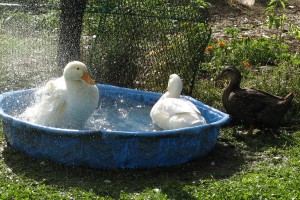 favorite was Ping, an Indian Runner who looked like one of those kid’s toys that has a long stick and two wheels. I’d be milking the goats and hear quacking. Looking out the door, I’d see them coming up the road in their little group, which I dubbed “The Committee.” They were by far the busiest animals I’ve ever seen on a farm. When they weren’t taking a walk down the road, they were searching for bugs in the grass, or going for a swim in their pool. Very occasionally, I’d see them sleeping in the shade of a flower bed.
favorite was Ping, an Indian Runner who looked like one of those kid’s toys that has a long stick and two wheels. I’d be milking the goats and hear quacking. Looking out the door, I’d see them coming up the road in their little group, which I dubbed “The Committee.” They were by far the busiest animals I’ve ever seen on a farm. When they weren’t taking a walk down the road, they were searching for bugs in the grass, or going for a swim in their pool. Very occasionally, I’d see them sleeping in the shade of a flower bed.
Alison uses the goats’ milk to make yogurt and cheese. On one day she made cheddar. The milk was handled in the standard way with heating and adding culture and rennet to separate the curds and whey. But there was an additional step called cheddaring where the curds are cut into pieces and stacked on top of each other. The stacks are turned over and restacked a few times. This helps the whey drain out and the curds to stretch. It results in a harder cheese.
On my last day on the farm, I went to the top of Putney Mountain to look for hawks migrating south. Putney Mountain is a famous spot for hawk watching in the fall. Monarch butterflies also pass by. On the beautiful sunny morning I was there, I was rewarded with six blue jays, one sharped shin hawk, and a lovely view of the surrounding hills.


